Measuring Marketing Effectiveness: Find Out if Your Content Converts
- Fahad H

- Apr 30, 2014
- 5 min read
I recently wrote an
article discussing ways to measure content marketing performance in association with brand awareness, thought leadership, and engagement metrics — three important goals for B2B marketers in 2014. But lead generation and customer acquisition are also important goals for content marketing programs; in fact, they are second and third on the priority list, according to CMI’s 2014 B2B Content Marketing Trends report. This tie-in is particularly critical when aligning marketing to the broader sales initiative.
In this article, I plan to dive into techniques for measuring the marketing effectiveness of the content we create for these critical goals, and discuss a model for establishing lead generation and customer acquisition performance metrics that my company uses in the campaigns we run. Hopefully you will find these ideas and tactics to be helpful in your organization’s evaluation of B2B content marketing campaigns, as well.
Develop multiple levels of conversion opportunities
First off, it’s important to realize that not all content marketing assets are designed to drive immediate, sales-ready leads for an organization. There is a spectrum of content marketing assets, each with its own relationship to prospecting goals and business objectives — concepts that Eloqua did an excellent job of (re-)outlining in its 2011 infographic, The Content Grid.
The important takeaway from this was that content marketers must develop and track the awareness of content assets across a range of buyer behaviors and search objectives. As was also noted in my company’s recent
B2B Web Usability Report, 50 percent of survey respondents indicated they visit a vendor’s website three to five times before contacting a vendor.
To give your B2B content marketing program a chance to prove that it is worth investing in, it is essential to track multiple conversion types in your web reporting software, broken down by sales readiness level. One mechanism for doing this is through Goal Tracking in Google Analytics.
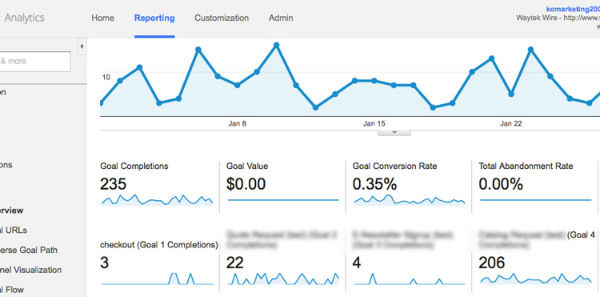
Some of the types of conversions we recommend breaking out based on sales readiness include (from highest priority for sales communication):
Sales evaluations and demo requests
White paper and premium content requests
Subscriptions requiring email information (newsletters, offers, etc.)
Views on content assets (videos, PDF downloads, etc).
Implementation tips: Goals across the various levels of conversion action can be established through your reporting software. For more details on this, check out this post on tracking and monetizing your website conversions, as well as Google Analytics’ specific conversion tracking instructions.
Of course, expectations for conversion rates and overall volume per conversion type need to shift, as well. For example, sales-ready conversions will often be lower than the conversion rates and volume associated with more informational or research-oriented conversion types.
The good news is that when B2B marketers define a more comprehensive level of goal tracking through Google Analytics, we can achieve a much greater understanding of the lead generation impact of content marketing performance.
Content marketing asset activity and event tracking
B2B marketers can’t put all of their content marketing assets behind form submissions and pay walls, no matter how much of a benefit this might provide for lead-gen and customer acquisition efforts. (For example, are you really going to require a form submission to view a case study or watch a customer success video? I hope not.) For measuring the marketing effectiveness of assets that are less sales-ready, Google Analytics event tracking is one solution.
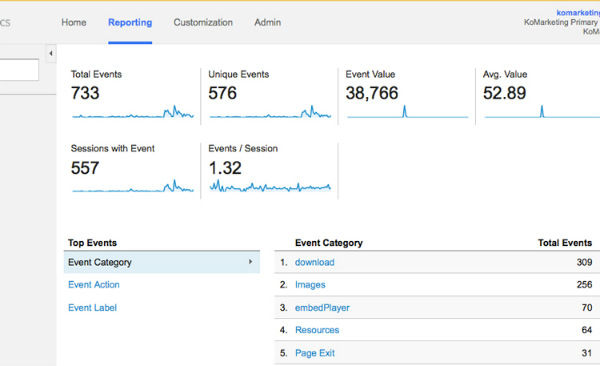
By adding a simple piece of code to links associated with images, navigation tabs, graphics, and hyperlinks, B2B marketers can build more effective reports on how visitors interact with their website and content assets. This is invaluable for understanding whether or not the content published online is actually being accessed beyond standard “page views” or “entrances.”
What can B2B marketers measure through event tracking? Consider the following:
File downloads
Video playbacks
Click-throughs to company landing pages (such as webinar registration pages, event registrations, etc)
Implementation tips: Carrie Hill shares an easy-to-follow tutorial for setting up event tracking in this article and Google offers a more comprehensive resource in its developer center.
A few recommendations to consider:
Use a consistent taxonomy of information, so Google Analytics reporting is easy to interpret.
I tend to define events based on type of action (such as “PDF download”) and location of action (such as “home page” or “side navigation”).
Don’t forget to test your code! Make sure your event tracking code is working correctly once implemented.
Content marketing asset activity and visitor prospect reports
From the customer acquisition standpoint, marketing automation prospect reports are one of the best tools we have for learning what pages and site assets a prospect has viewed. It’s also the perfect report for demonstrating how impactful content is at turning those prospects into customers.
Here are a couple screenshot examples from marketing automation tools we use on behalf of our client initiatives:
An example of Pardot’s visitor page views report:
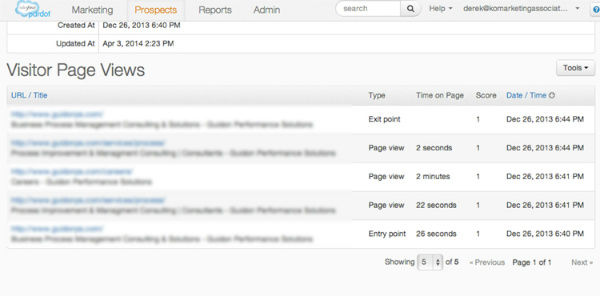
Marketo’s activity log report (via Leadsloth):
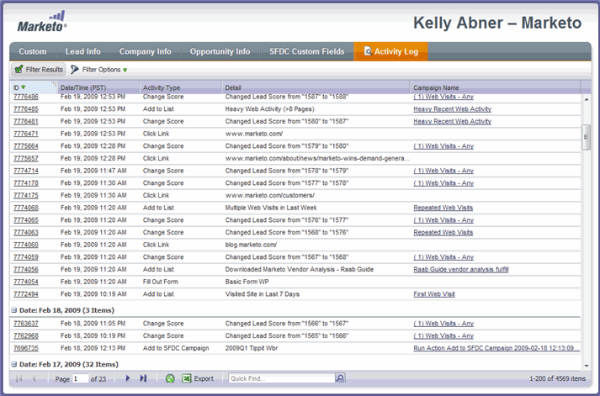
Reports like these help B2B marketers illustrate the number of times a prospect viewed the content marketing assets they’ve developed. As prospects turn into closed sales, further analysis of these reports can be done to demonstrate the impact of content marketing efforts and their influence on the sales process.
Navigational performance of content marketing assets
One final report in Google Analytics that might be helpful is the navigational summary associated to content marketing asset activity, which can be found thusly:
Behavior à All Pages à “PAGE” (i.e., web address of content marketing asset) à toggle to “Navigation Summary” tab

The navigation summary illustrates “Next Page Paths,” or the next web page on the site that visitors went during their session. In the screenshot below, I am highlighting pages that visitors viewed, which were specific to products and solutions pages related to the article we developed, as well as pages with direct form submissions/sales-ready calls-to-action.
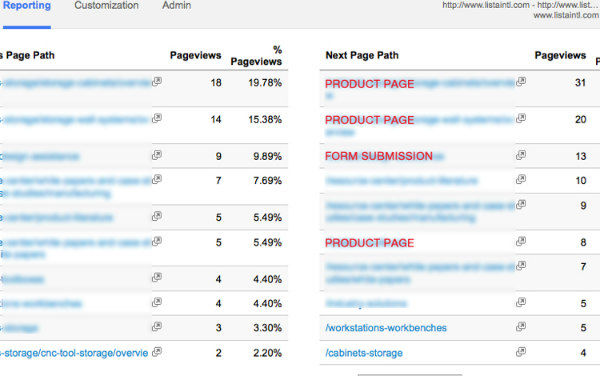
Unfortunately, this report does not confirm goal completion, but it can help B2B content marketers support the relationship between content marketing assets developed and connectivity to more sales-oriented material.
Targeted social media mentions
Social media should also play a strong part in demonstrating content marketing performance. Unfortunately, social share counts can sometimes be seen as more of a vanity metric and don’t really explain the story of how impactful social was (or was not) in lead generation or customer acquisition efforts. For B2B content marketers to truly align social sharing with customer engagement, or even with thought leadership, a deeper evaluation of the people who are sharing your content is required.
Here are a few recommended ways for tracking this performance:
Keep tabs on relevant Twitter users who share, mention, or retweet your updates by favoriting their updates. Not only does Twitter favoriting act like a bookmark, but the user also can see this activity and it acts almost like a “Thank you” (or at least acknowledgment) for the engagement.
Organize lists of relevant profiles in Twitter, LinkedIn (through tags), and Google+ (through circles) to enable better focus. This can be especially important if you are managing a large social network and interaction rates are high.
When all else fails, capture screenshots of performance stats, when possible. This is especially true for social platforms like LinkedIn, and Facebook, where there isn’t a mechanism for archiving the individual profiles that “liked” or shared one of your updates.
We don’t really use commercial software for tracking social media performance, outside of a handful of SEO tools with built in monitoring solutions. And in these specific cases, I don’t find their monitoring solutions powerful enough in the evaluation of social mentions we need, for content marketing evaluation.
As such, most of our performance monitoring in this area is handled somewhat manually. I am pretty certain more comprehensive social media reporting platforms allow for some type of tracking and archiving of influential conversations and engagement. The key would be defining the objectives of conversations and mentions being tracked. (I’d love to read your perspective and feedback on the topic of commercial social media monitoring solutions in the comments below.)
Final thoughts
At the end of the day, the marketing tie-in to the sales process and customer journey are critical. Hopefully these tactics and measurement strategies help demonstrate success in those efforts for your content marketing initiatives.
Did I miss anything? I certainly welcome feedback and perspective via comments below.
Looking for additional guidance on ways to manage today’s biggest content marketing challenges? Sign up for our new Content Marketing Institute Online Training and Certification program. Access over 35 courses, taught by experts from Google, Mashable, SAP, and more.
Cover image via Bigstock








Comments